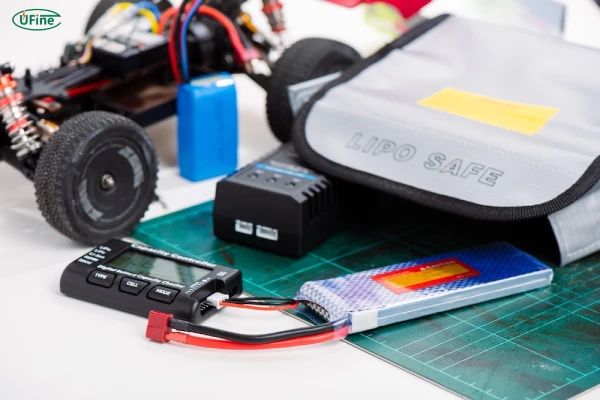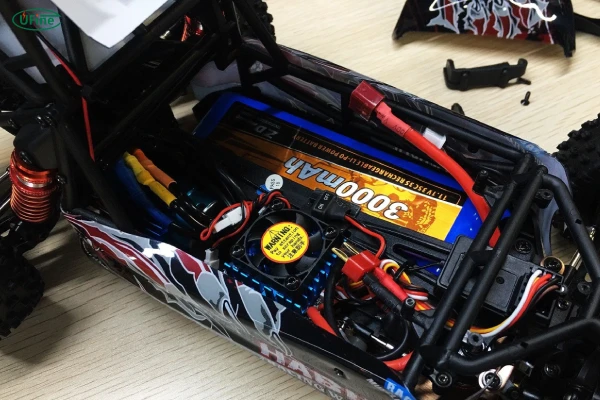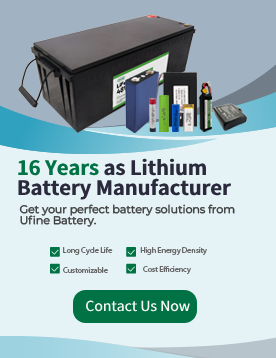
- Part 1. Understanding RC car battery packs
- Part 2. Different types of RC car battery packs and their lifespan
- Part 3. What exactly is a charge cycle?
- Part 4. Key factors that influence RC car battery lifespan
- Part 5. How to calculate battery life for your RC car
- Part 6. How to choose the right charger for your RC car battery pack
- Part 7. Best practices to charge RC car battery packs properly
- Part 8. How to maintain and care for your RC car battery packs
- Part 9. When to replace your RC car battery pack
- Part 10. FAQs
Part 1. Understanding RC car battery packs
Before discussing lifespan, it’s important to understand some fundamental concepts about RC car battery packs, especially voltage and capacity
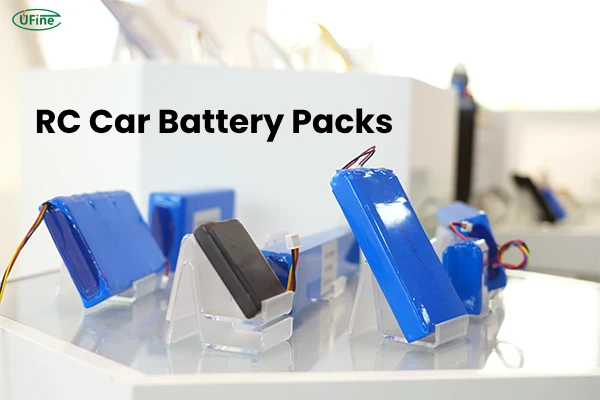
Voltage: The Power Output
Voltage is the electrical potential the battery provides, usually measured in volts (V). In RC cars, common battery voltages include:
- 6 volts (V) — Often from NiMH packs with 5 cells (1.2V each). Suitable for beginner models.
- 7.4V — Typically a 2-cell (2S) LiPo pack, offering better power and speed.
- 11.1V — A 3-cell (3S) LiPo pack for high-performance RC cars.
Voltage influences your car’s speed and torque. However, using a battery with too high a voltage for your RC car can cause damage.
Capacity: How Long It Runs
Capacity, measured in milliampere-hours (mAh), indicates how much charge a battery holds. A higher capacity means longer runtime. For example, a 5000mAh pack can generally power your car longer than a 2000mAh pack.
However, capacity isn’t the only factor in runtime — the efficiency of your motor and the weight of the battery also matter.
If you want a high-quality, custom lithium battery pack for your RC car, consider Ufine Battery. Based in China, Ufine Battery manufactures a wide range of lithium batteries including:
- Lithium polymer (LiPo) batteries
- LiFePO4 batteries
- 18650 and various cylindrical batteries
- Ultra-thin batteries
- High-rate and high- or low-temperature batteries
We specialize in customizing lithium batteries of various sizes, voltages, capacities, and discharge rates to fit diverse applications—including RC cars. If you have unique power needs or want a battery pack optimized for your RC vehicle, we can help.
Contact us today to get a custom RC car battery pack that balances power, runtime, and lifespan perfectly.
Part 2. Different types of RC car battery packs and their lifespan
RC car battery packs come mainly in three types: Nickel-Metal Hydride (NiMH), Lithium Polymer (LiPo), and Lithium Iron Phosphate (LiFePO4). Each type has its own characteristics and typical lifespan.
Nickel-Metal Hydride (NiMH)
NiMH batteries have been a standard for years due to their durability and relatively low cost.
- Typical Lifespan: Around 300 to 500 full charge cycles.
- Advantages: Tough, safer, less sensitive to charging errors.
- Disadvantages: Heavier and lower energy density than LiPo batteries.
NiMH batteries gradually lose capacity with each charge cycle. You might notice your RC car running shorter times after about a year of regular use.
Lithium Polymer (LiPo)
LiPo batteries are popular for their high energy density and light weight.
- Typical Lifespan: About 200 to 300 full charge cycles.
- Advantages: Lightweight, deliver higher voltage and power output.
- Disadvantages: Require careful charging and storage; risk of swelling or fire if mishandled.
LiPo packs degrade faster if not properly cared for. However, when handled right, they provide superior performance.
Lithium Iron Phosphate (LiFePO4)
LiFePO4 batteries are less common in RC cars but growing in popularity.
- Typical Lifespan: Up to 1000 or more full charge cycles.
- Advantages: Safer chemistry, very stable, longer cycle life.
- Disadvantages: Lower voltage per cell; heavier than LiPo; more expensive.
These batteries can be a great option if longevity and safety are your priorities.
Part 3. What exactly is a charge cycle?
Understanding what counts as a charge cycle helps in estimating battery lifespan more accurately. A charge cycle refers to using and recharging the battery fully once.
However, if you only use half the battery’s capacity before recharging, that counts as half a cycle. For example, if you discharge your battery to 50% and recharge it twice, that equals one full charge cycle.
Part 4. Key factors that influence RC car battery lifespan
Now that we know typical lifespan ranges, let’s explore the most important factors affecting how long your RC car battery pack will last.
a) Charging Practices
Charging has the biggest impact on battery health.
- Overcharging: Leaving batteries plugged in too long can cause overheating or damage.
- Undercharging: Consistently stopping before fully charging can also reduce lifespan.
- Using the wrong charger: Chargers designed for other battery chemistries or voltages can damage your pack.
Always use a charger compatible with your battery type, and follow manufacturer guidelines closely.
b) Discharging Habits
Deep discharging (using the battery until it’s completely empty) can permanently reduce capacity.
Most batteries perform best if recharged before the voltage drops too low. For example, LiPo batteries shouldn’t drop below about 3.0 volts per cell.
c) Storage Conditions
Where and how you store your RC car battery packs matters a lot.
- Temperature: High heat accelerates battery degradation. Store batteries in a cool place (ideally 15–25°C).
- Charge level: For long-term storage, batteries should be stored at about 50% charge. Fully charged or fully discharged storage causes faster aging.
Using a battery storage bag or container helps keep the batteries safe and at stable conditions.
d) Usage and Load
Heavy use — such as running your RC car at full throttle for extended periods — puts more stress on the battery, shortening its life.
Additionally, using a battery pack with a discharge rate too low for your motor’s power draw can cause overheating and damage.
e) Battery Quality and Brand
Not all batteries are created equal. High-quality battery packs from reputable brands usually last longer because of better materials and manufacturing standards.
Part 5. How to calculate battery life for your RC car
You might wonder: “How many minutes can I expect from a full charge?”
While it depends on many factors, here’s a rough formula to estimate runtime:
Runtime (hours) = Battery Capacity (mAh) ÷ (Average Current Draw in mA)
For example, if your RC car draws 10 amps (10,000 mA) and your battery capacity is 5000mAh:
Runtime = 5000 ÷ 10,000 = 0.5 hours or 30 minutes.
Keep in mind, actual runtime varies with speed, terrain, and driving style.
Part 6. How to choose the right charger for your RC car battery pack
A good charger is essential for maintaining battery health. Here’s what to consider:
- Battery chemistry compatibility: NiMH and LiPo chargers are very different. Never use a LiPo charger on NiMH batteries or vice versa.
- Balance charging: Especially for LiPo batteries, balance chargers ensure each cell is charged evenly. This prevents overcharging individual cells.
- Safety features: Look for chargers with overcharge protection, temperature sensors, and automatic cut-off.
- Charge rate: Slow charging (1C or less) is gentler on batteries, extending their lifespan. Fast chargers offer convenience but can degrade batteries if used excessively.
Part 7. Best practices to charge RC car battery packs properly
Charging your battery correctly will help it last longer:
- Always monitor charging; never leave batteries unattended.
- Charge batteries on a non-flammable surface or use a LiPo safety bag.
- Avoid charging swollen or damaged batteries — they may be unsafe.
- For NiMH, use a smart charger that stops charging when full.
- For LiPo, always balance charge every time.
- Let the battery cool down before charging if it’s warm from use.
Part 8. How to maintain and care for your RC car battery packs
Proper maintenance can dramatically extend battery life.
- Storage: Store batteries at about 50% charge, in a cool, dry place.
- Regular checks: Inspect batteries before use for swelling, leaks, or damage.
- Cleaning: Keep connectors clean and dry for optimal performance.
- Avoid physical shocks: Don’t drop or crush your battery packs.
- Cycle occasionally: For NiMH batteries, fully discharge and recharge every few months to maintain performance.
- Use battery balancers: For LiPo packs, balancing keeps each cell healthy and extends pack life.
Part 9. When to replace your RC car battery pack
Knowing when to replace your battery pack is vital for performance and safety.
Look for these signs:
- Significantly reduced runtime despite full charge.
- Battery swelling or puffing — a serious warning.
- Difficulty charging or batteries not holding charge.
- Voltage drops quickly under load.
- Physical damage such as leaks or cracks.
If you notice any of these, it’s time to replace the battery pack.
Part 10. FAQs
How long does a typical RC car battery pack last in use?
Usually, a full charge runs between 10 to 30 minutes, depending on battery capacity and driving style.
Can I use the same charger for different battery types?
No. Chargers must match the battery chemistry (NiMH, LiPo, etc.) to avoid damage.
How can I extend the lifespan of my RC car battery pack?
Use the correct charger, avoid deep discharges, store properly, and maintain your batteries regularly.
Is it safe to charge LiPo batteries overnight?
It’s generally not recommended unless you have a high-quality charger with safety features and you monitor the process closely.
What causes my battery to swell or puff?
Overcharging, overheating, physical damage, or age can cause swelling. Swollen batteries are unsafe and should be disposed of properly.
Related Tags:
More Articles
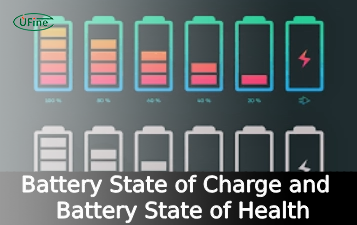
Battery State of Charge and Battery State of Health
Battery SoC vs. SoH explained: Learn professional methods to measure charge levels, test health status, and optimize battery performance for longer lifespan.
Difference Between 18650, 26650, and 21700 Batteries
What’s the difference between 18650, 21700, and 26650 batteries? Compare size, capacity, and performance to find the best lithium battery for your device.
LFP Battery Vs. LTO Battery: A Detailed Comparison
Compare LFP (LiFePO4) and LTO (Lithium Titanate) batteries by energy density, lifespan, safety, cost, and uses in EVs, solar storage, and backup power.
Compare 18650 battery types: Li-ion, LiFePO4, and LiPo. Key specs (voltage/capacity) and best uses for vapes, flashlights, EV batteries.
How to Distinguish Between Grade A, Grade B, and Grade C LiFePO4 cells?
Explore the differences between Grade A, B, and C LiFePO4 cells and learn how to choose the right one for electric vehicles, solar storage, or backup power.
